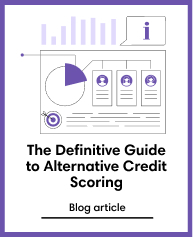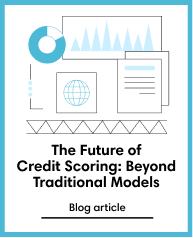Credit Scoring
Nov 5, 2021
Why is the traditional credit rating system losing steam?
Subscribe to our newsletter
Until a few years ago, a credit score was typically obtained through traditional credit scoring methods. Traditional credit scores or ratings result from a credit analysis performed by different credit bureaus, indicating whether or not a person or institution is soluble enough to obtain a loan.
Previously, these traditional institutions were the only ones that had the ability to analyse and score the financial history of a natural or legal person. However, nowadays, with the emergence of advanced technologies and the democratisation of information, new companies that have the ability to perform more accurate credit ratings have taken shape.
These so-called alternative credit scores have been gaining ground over traditional scores due to their multiple benefits, such as access to numerous sources of information, the possibility of making future predictions, their ability to prevent fraud, the opportunity to open up new markets, together with the capacity for continuous improvement.
In this blog, let us explore what is traditional credit, why the credit rating system built on it is losing steam, and how lenders are turning to alternative models.
What Is Traditional Credit Analysis?
Traditional credit analysis is the long-established method used by lenders to evaluate an applicant’s creditworthiness. It relies heavily on financial information such as credit history, income stability, outstanding debts, and credit utilisation.
Traditional credit analysis also prioritises historical performance over real-time insights, which means it may not fully capture an applicant’s current financial behaviour or capacity to repay. This backwards-looking approach can disadvantage borrowers who have recently improved their financial habits but remain penalised for past difficulties.
The process typically uses reports from credit bureaus that consolidate borrower data into a score or summary. Lenders review repayment histories and current obligations to judge whether an applicant poses a default risk.
However, traditional credit analysis depends largely on manual processes and fixed rules. This approach can create delays in approval times and limit accessibility for individuals with thin or no credit files.
Traditional vs. Alternative Credit Scoring: What’s the Difference?
Traditional credit scoring and alternative credit scoring models differ significantly in the types of data they use and in the analytical methods applied. Traditional systems depend on bureau records, while alternative methods expand to include alternative data.
Below is a comparison of the two approaches:
- Data Sources
- Traditional: Credit bureaus, bank records, repayment history.
- Alternative: Telco usage, rent payments, utility bills, and behavioural signals.
- Evaluation Methods
- Traditional: Manual checks and static scoring models.
- Alternative: Automated systems using machine learning (ML) and real-time signals.
- Accuracy
- Traditional: Good for borrowers with long histories but weak for thin-file applicants.
- Alternative: Broader coverage improves accuracy and inclusivity.
- Fraud Risk
- Traditional: Limited ability to detect synthetic identities.
- Alternative: Advanced algorithms spot anomalies in behaviour and device activity.
- Inclusivity
- Traditional: Excludes unbanked or underserved individuals.
- Alternative: Expands access to millions previously invisible to lenders.
This contrast illustrates why alternative approaches are increasingly seen as essential complements to bureau-based credit scoring. By incorporating broader datasets and automation, they provide faster, fairer, and more inclusive assessments of creditworthiness.
What Are Traditional and Alternative Types of Credit?
Most people have a common doubt: “what are traditional and alternative types of credit?”. It is useful to examine how each operates. Traditional credit includes products like credit cards, personal loans, and mortgages. These are well-documented in bureau files and form the backbone of traditional credit scoring models.
alternative credit, by contrast, refers to buy-now-pay-later (BNPL), short-term mobile loans, rental payments, and utility bills. These categories were historically excluded from formal reports but are now increasingly considered by alternative models.
Examples of Each Credit Type
This side-by-side view shows how expanding recognition of credit types improves inclusivity.
How Alternative Credit Builds a Financial Profile
Repayment records from alternative sources demonstrate reliability even when bureau data is thin. Increasingly, these signals are included in bureau files or alternative scoring frameworks.
By factoring in diverse repayment patterns, alternative credit helps create a more complete financial profile, reducing exclusion for individuals without a long banking history.
From Limited Data to Endless Sources of Insight
One of the reasons traditional credit scoring methods have lost steam is that they rely on a single source of information, which is a person’s credit history. In contrast, new alternative scores derive from multiple data sources that proliferate automatically thanks to ML.
A credit history is a record that indicates all the movements and states of a person within the financial system. It is a linear register that can see the past within the framework of the banking system, but is incapable of outgrowing that context and understanding the total behaviour of a person in different aspects of their daily life.
In contrast, new alternative scoring uses data enrichment systems that can complete, in real time, each person's profile with information from multiple sources, allowing companies to understand their prospects better and make substantially more informed decisions.
Some of the data that an alternative credit rating may include are online purchases, bills and rent payments, social network behaviour, keyboard or mouse movements, among others.
Key Challenges of Traditional Credit Analysis
Despite its long use, traditional credit analysis faces mounting criticisms. One of the most significant challenges is its sole reliance on outdated or incomplete data, which limits predictive accuracy. Borrowers with no formal credit history are often excluded entirely, creating financial exclusion for millions.
Bias is another major issue. Scoring models built solely on bureau data risk reinforcing systemic inequalities, as they often favour applicants from wealthier or urban backgrounds. Applicants from underserved or unbanked groups face barriers even if they are financially responsible.
Processing times also remain slow, with many cases routed through committees or manual reviews. This leads to inefficiencies and delays that are incompatible with modern, digital-first lending expectations.
Additionally, traditional credit scoring struggles to detect sophisticated fraud such as synthetic identities. Without robust alternative data or behavioural insights, institutions are left exposed to evolving threats. These challenges highlight why lenders are increasingly turning towards modern approaches that are faster, fairer, and more secure.
The Evolution of Credit Scoring: From Manual to Machine Learning
Credit scoring has undergone a significant transformation over the last century, adapting to changing economic and technological landscapes. In its earliest form, credit assessments were entirely manual, with bank managers relying heavily on personal judgement, references, and relationships to determine creditworthiness.
The introduction of credit bureaus marked the first step towards standardisation, consolidating repayment histories and debt records into centralised files. This development created consistency in decision-making and supported the rise of Fair Isaac Corporation (FICO) and other widely adopted scoring models, which remain core to many financial institutions today.
In recent years, however, lenders have turned to alternative approaches powered by telco data, behavioural signals, and ML algorithms. These innovations expand credit access, improve predictive accuracy, and enhance fraud detection, moving far beyond the limitations of traditional credit scoring.
The Ability to Make Future Predictions
ML algorithms collect diverse information and are capable of learning and modelling non-linear behaviours that anticipate the prospect’s habits. In this way, alternative scoring has a greater ability to prevent risks and anticipate customers' needs by offering products that are in line with their wants. In contrast, traditional scores do not have the technology to offer this type of prediction since the data processing systems are different.
Fraud Prevention
With the advancement of technology, fraud mechanisms have become more complex. That's why it's so important to have the right tools in order to detect fraudulent activities and to take action.
Alternative credit scoring uses state-of-the-art technology that allows companies to stay ahead of suspicious behaviour and set off the necessary alerts to mitigate risks. Instead, traditional scores require a much more arduous and manual process to find risk patterns.
Exploration of New Markets
Traditional rating schemes currently overlook people who are trustworthy but do not have a good credit history. However, alternative scoring offers new possibilities to people who are soluble but previously ignored, such as informal workers or students who are still young and do not participate in the banking system.
Thanks to alternative data, companies can obtain precise credit profiles and make informed decisions, and incorporate all of these currently forgotten people into the financial market.
The Acceleration of Processes and the Capacity of Constant Learning
Unlike traditional credit analysis, alternative credit scores can process information automatically and in real time without people’s supervision. Simultaneously, artificial intelligence algorithms have the ability to continuously learn, modify and complete the models with new data obtained.
Throughout history, technological discoveries have redefined our methods and mindsets to, surpass previous or outdated versions. Like how the printing press evolved from manually-operated machines to steam-powered machinery and then digital systems, new and modern forms of credit scoring have emerged to complement or and surpass traditional models.
Why Traditional Credit Analysis No Longer Meets Market Needs
In summary, traditional credit scoring is too narrow, overly manual, and far too slow for today’s digital-first lending markets. It places heavy reliance on bureau data and historical performance, which excludes thin-file or unbanked applicants, reinforces systemic bias, and struggles to adapt to new types of fraud.
Modern alternatives powered by behavioural signals and alternative data provide broader coverage and richer insights. They deliver faster, automated decisions while offering improved fraud detection and inclusivity. These models reflect the realities of digital finance, where agility and fairness are essential. The evidence demonstrates clearly why traditional frameworks must evolve.
FAQs About Traditional Credit Scoring
What Is Traditional Credit Analysis Based On?
It is based on bureau data such as repayment history, income stability, outstanding debts, and credit utilisation.
Why Is Relying Solely on Traditional Credit Scoring an Outdated Process?
It excludes unbanked individuals, has slower turnaround times, and cannot detect emerging fraud risks.
What Are the Traditional Credit Models?
Traditional credit models include FICO-style bureau scores and manual committee reviews, which form the basis of what are traditional credit systems.





